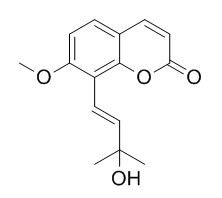Murraol
Murraol shows the significant proliferative activities on osteoblast-like UMR106 cells lines at the concentration of 1 × 10-10 mol/L. It and auraptenol show 63 ug/mL MIC value against Klebsiella pneumoniae ATCC 4352 and Bacillus subtilis ATCC 9372.
Inquire / Order:
manager@chemfaces.com
Technical Inquiries:
service@chemfaces.com
Tel:
+86-27-84237783
Fax:
+86-27-84254680
Address:
1 Building, No. 83, CheCheng Rd., Wuhan Economic and Technological Development Zone, Wuhan, Hubei 430056, PRC
Providing storage is as stated on the product vial and the vial is kept tightly sealed, the product can be stored for up to
24 months(2-8C).
Wherever possible, you should prepare and use solutions on the same day. However, if you need to make up stock solutions in advance, we recommend that you store the solution as aliquots in tightly sealed vials at -20C. Generally, these will be useable for up to two weeks. Before use, and prior to opening the vial we recommend that you allow your product to equilibrate to room temperature for at least 1 hour.
Need more advice on solubility, usage and handling? Please email to: service@chemfaces.com
The packaging of the product may have turned upside down during transportation, resulting in the natural compounds adhering to the neck or cap of the vial. take the vial out of its packaging and gently shake to let the compounds fall to the bottom of the vial. for liquid products, centrifuge at 200-500 RPM to gather the liquid at the bottom of the vial. try to avoid loss or contamination during handling.
J Neuroinflammation.2023, 20(1):268.
Exp Parasitol.2017, 183:160-166
Cells.2022, 11(8), 1311.
Journal of Chromatography A2020, 460942
Antioxidants (Basel).2022, 11(12):2411.
Evid Based Complement Alternat Med.2021, 2021:8850744.
Appl Microbiol Biotechnol.2024, 108(1):207.
Pharmaceuticals (Basel).2021, 14(3):260.
Molecules.2024, 29(5):1050.
Food Chem. 2020, 320:126530
Related and Featured Products
Nat Prod Res. 2006 Aug;20(10):909-16.
Antiproliferative effects of isopentenylated coumarins isolated from Phellolophium madagascariense Baker.[Pubmed:
16854718]
METHODS AND RESULTS:
From the leaves of Phellolophium madagascariense Baker (Apiaceae), an endemic herb to Madagascar, three known coumarins (osthol, Murraol and meranzin hydrate) have been isolated and identified. This is the first report of these compounds in this species. The structural elucidations were based on the analysis of physical and spectroscopic data.
CONCLUSIONS:
The anticancer activity of the three isolated compounds and of a synthetic sample of osthol was evaluated on L1210 mouse leukemia and on human prostatic cancer hormonosensitive LNCaP and hormonoindependent PC3 and DU145 cell lines.
Molecules. 2017 Jul 1;22(7).
Antibacterial Activities of Pyrenylated Coumarins from the Roots of Prangos hulusii.[Pubmed:
28671568 ]
The dichloromethane extract of the roots of Prangos hulusii, a recently described endemic species from Turkey, has yielded nine known and one new prenylated coumarins.
METHODS AND RESULTS:
The structures were elucidated by spectroscopic methods and direct comparison with the reference compounds where available. The root extract and its prenylated coumarins exhibit antimicrobial activity against nine standard and six clinically isolated strains at a concentration between 5 and 125 µg/mL. In particular, the new coumarin, 4'-senecioiloxyosthol (1), displayed 5 µg/mL MIC (Minimum Inhibitory Concentration) value against Bacillus subtilis ATCC 9372, Murraol (4) and auraptenol (5) showed 63 µg/mL MIC value against Klebsiella pneumoniae ATCC 4352 and Bacillus subtilis ATCC 9372, and isoimperatorin (9) exhibited 16 µg/mL MIC value.
Zhong Cao Yao, 2016, 47(17):2993-6.
Download citationShare Request full-text Chemical constituents isolated from fruits of Cnidium monnieri and their effects on proliferation of UMR106 cells[Reference:
WebLink]
To study the chemical constituents from the fruits of Cnidium monnieri and their effects on proliferation of UMR106 cells.
METHODS AND RESULTS:
The constituents were separated by column chromatography, and their structures were elucidated by spectroscopic data analyses. The proliferation of all isolated compounds on osteoblast-like UMR106 cells was determined. Nine compounds were isolated and identified as 5,7-dihydroxy-6,8-dimethoxy-2-methyl-4H-chromen-4-one (1), 5-hydroxy-2- hydroxymethyl-4H-chromen-4-one (2), (+)-marmesin (3), bergaptol (4), isobergapten (5), 7-hydroxy-8-(2',3'-dihydroxy-3'-methyl-butyl)-coumarin (6), Murraol (7), coniferyl aldehyde (8), and m-hydroxybenzoic acid (9). Compounds 1, 3, and 7 showed the significant proliferative activities on UMR106 cells lines at the concentration of 1 × 10⁻1⁰ mol/L and the proliferative ratios were 31.55%, 32.39% and 30.87%.
CONCLUSIONS:
Compounds 1-6 are isolated from the specie of Cnidium Cusson for the first time. Compounds 1, 3, and 7 increase UMR106 cells proliferation to some extent.



